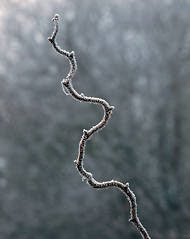I first discovered the work of Martin Parr some years ago before I took up photography as a hobby. Some of his photographs appeared in a weekend newspaper magazine with an article about his work. I immediately thought here was an entertaining photographer with a sense of humour. He was using colour, and photographing ordinary everyday things, presenting them in ways that seemed extraordinary. I could relate to this photography since these were the scenes and events that I was involved in and witnessing. I was not aware of any other photographer that was working in this way. Serious photographers were using black & white and if it wasn't news related it seemed to be fashion and glamour photography. The only other photographers I was aware of at this time was David Baily, I remember his photos of Jean Shrimpton and later Twiggy, and Patrick Lichfield the society photographer.
Martin Parr was born in Epsom Surrey in 1952 and studied photography at Manchester Polytechnic, he was encouraged, early on by his Grandfather who was a keen amateur photographer and has built up an international reputation for his interpretation of social documentary, he became a member of Magnum Photographic Corporation in 1994.
The Barbican Art Gallery and National Media Museum put together a retrospective of his work in 2002 and this toured Europe for five years. More recently he has become interested in film making, advertising and fashion. In 2004 he was awarded a Professorship of Photography at the University of Wales, Newport Campus, as well as being appointed Guest Artistic Directore for Rencontres D'Arles. In 2006 he was awarded the Erich Salomon Prize and in 2008 was guest curator at New York Photo Festival.
Parrworld, an exhibition of his own collections of objects such as postcards, photos and photobooks by international artists and his own photos opened in Munich in 2008 and toured Europe of two years, in the same year he won the Baumer Mercier award at PhotoEspana in recognition of his career and contribution to contemporary photography. He will be curating the Brighton Photo Biennial in October this year.
Most of the images below are taken from 'The Last Resort' first published in 1986 and 'Think of England' published in 2000.
This is one of my favourite images with seagulls stealing chips, the two seagulls make a very balanced picture almost a reflection of each other, with the background falling out of focus to concentrate on the main subject, the birds. To reinforce

location the flag is included and because of its almost distracting colours, it draws attention and makes the viewer explore all of the picture.
This image is a great use of thirds with the sky taking up a large part and excluding a great deal of distracting information in the foreground. The small area of detail in the right foreground is instantly recognisable as a deckchair and again places the image in Britain.
The image above could be almost any holiday location but detail in the background, promenade railings, deckchairs, coastline and to some extent the figure in the foreground wrapped up against a cool breeze, give a clue and tell a story of the British seaside.
Lots of detail in focus in this image but the colourful flag draws the eye from a curious seagull in the foreground around the picture and into the background.

A typically British pastime, looking for the ball, a simple image that tells a whole story. Perhaps Glyndebourne is more obscure, but not to Martin Parr from a middle class background.
At first glance it would appear these pictures are taken in haste and it is true that many are scenes that the photographer has opportunistically taken. However, they are all well put together, with a striking focal point drawing the viewer into the scene and telling how we like to spend our leisure time, telling a story.
I recently attended a seminar at Burton College with MartinParr as the guest speaker, as I anticipated he is a very amusing and entertaining speaker and he regailed us with his early experiences, reiterating on more than one occasion that he is from a middle class background. I had to wonder if this was one of the reasons for his success, since he was able to sustain himself independently whilst forging his early career as well as finding his early subjects of mainly working class people and attitudes interesting.
Most of his photos appear to be taken using a 35mm camera, he told us that in his experience people did not object to being photographed and it often depended on how the subject was approached, if an authorative, friendly and confidant manner was used then problems were not usually encountered.




I have included some of my own photos above, in which I have tried to capture interiors, from a similar era to those taken by Martin Parr, and I think the style of which we will all be familiar with. As social documentary they record the style and tastes of the time.
I have also added more of Martin Parr's work on my Picasa site, please
click here to view.








.jpg)
.jpg)

.jpg)
.jpg)












.jpg)
.jpg)







































